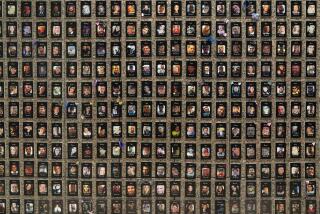Children Born Addicted to Crack Defy Experts : Growth: Crack-exposed babies may develop more slowly than others, but may grow out of early problems, experts say.
- Share via
NEW YORK — When they spotted the playground, looming like a leafy oasis amid the graffiti-scarred tenements of central Harlem, the 10 toddlers and pre-schoolers erupted in excitement.
As they entered Morningside Park, the older kids raced to the swings and slides. The younger ones clapped their hands and cheered them on.
Within seconds, the children were indistinguishable from the other youngsters in the park, swooping down slides and climbing monkey bars.
Three-year-old Johnny scrambled up the slide so fast that kids from a nearby school watched in awe. Two-year-old Tanika jumped onto the jungle gym like a tiny mountain goat.
This wasn’t supposed to happen. These children, on their daily outing from Hale House, were born exposed to crack. In recent years, the term “crack babies” has become a national buzzword, a riveting soundbite that conjures images of mutant, monster children.
Punchy headlines such as “Crack Babies: Genetic Inferiors” and “Crack in the Cradle” have helped shape the stereotype.
But the children themselves may have the last word. Doctors, social workers and teachers involved with crack-exposed kids indicate that many are rising above the dire predictions made for them.
“When people find out what I do, they say, ‘Oh, those poor crack babies,’ ” said Hale House nurse Anne Marie Nedd as she chased active, giggling 18-month-old Darren around the park. “I get so mad. I tell them, ‘There’s nothing really wrong with these kids!’ ”
*
Since crack first swept the country in 1985, children born to crack addicts were thought to be physically and mentally damaged, doomed to a marginal life and an ongoing burden for taxpayers.
The first wave of crack-exposed children entered first and second grades in New York City this fall, a year after one state report estimated the cost of special care for them could total $2 billion over the next 15 years. Harlem Hospital researchers estimated that the cost of caring for crack babies costs the country $500 million a year.
Such statistics have fed the kind of fear that led Ross Perot to invoke the dread specter of “crack babies” during the first presidential debate last fall.
“Again and again and again, the mother disappears in three days and the child becomes a ward of the state because he’s permanently and genetically damaged,” Perot said.
Permanently and genetically damaged. That’s the kind of description that angers Hale House program director Jackie Edmond as she feeds beaming, alert 6-month-old Quashia some apple sauce. Hale House cares for children 3 and under born addicted to drugs. Like Quashia, almost all the kids there now were born addicted to crack.
“Tell me, what does a crack baby look like?” Edmond asks angrily as she recounts the stories she’s read about crack babies and the comments she hears from strangers. “Nobody who talks about them ever comes in to see them. They’ll come in here and look at our kids and they look normal. So they say, ‘Where are the drug babies?’ I tell them, ‘They’re right here.’ ”
Across town on Wards Island, watching a group of animated 3- and 4-year-olds reading aloud from workbooks in a sunny room at Odyssey House, Cheryl Nazario had the same reaction.
“These kids were labeled a lost cause,” said Nazario, who directs a residential program helping former crack addicts and their children. “It was like everyone expected them to walk into schools like little androids. But they catch up. They really do catch up.”
*
While crack-exposed babies may develop more slowly than others, many experts say they often appear to grow out of early problems if they receive proper care as infants and toddlers. Many believe their prognosis is as good as children born drug-free if they get early intervention.
Such children have to overcome a lot. The gripping image of the jittery, irritable baby who doesn’t want to be touched and cries all the time is a reality, experts say. But kids born to mothers addicted to other drugs share the same symptoms, the result of a disorganized nervous system.
Programs all over the country, including Hale House and Odyssey House in New York and the Charles R. Drew Head Start in South-Central Los Angeles, have developed strategies to lessen the symptoms, help kids adapt to their surroundings and teach parents how to better care for them.
Many experts who have researched or worked with kids exposed to cocaine decry what some call the myth of “crack babies.”
“It’s nonsense,” said Claire Coles, a clinical psychologist at Emory University in Atlanta who has studied crack kids. “There’s no evidence of genetic damage, nothing like what was originally supposed. It’s astonishing that so much fuss has been raised about cocaine when kids born with fetal alcohol syndrome are so much worse off.”
The problems suffered by children exposed to cocaine stem from many factors, Coles said. Many were born prematurely to mothers who had little or no prenatal care and are returned to a neglectful environment. But cocaine itself has not been proven to be any more damaging than any other drug used by pregnant women, Coles said.
Those familiar with crack-exposed children also echoed Coles’ assertion that children with fetal alcohol syndrome are much more likely to suffer from mental retardation.
Researchers at the National Assn. for Perinatal Addiction Research and Education in Chicago have tracked a group of 300 children born exposed to crack for almost seven years, while helping the children and their mothers.
The association’s president, Ira Chasnoff, said youngsters born exposed to crack, or other drugs, often suffer from a decreased attention span, more impulsive behavior and have difficulty concentrating. But environment may play a more key role than drug exposure in the womb, he said.
In NAPARE’s study, researchers found that the IQ scores of children born exposed to crack were the same as children who were not crack-exposed but who lived in a similar environment.
Chasnoff painted a dark picture behind society’s morbid embrace of “crack babies.”
“The image of the crack baby really moved out there,” he said. “Politicians really picked it up. It worked into the trend of writing about the underclass. It’s sexy, it’s interesting, it sells newspapers and it perpetuates the us-versus-them idea.”
In fact, said Chasnoff, “Poverty is the worst thing that can happen to a child.”
*
In the second-floor nursery at Hale House, Quashia sits in her walker gazing at Jackie Edmond with a wide smile and lively eyes. She is healthy, bright and is developing both physically and mentally at the same rate as a child born drug-free, Edmond said.
But the outlook for Quashia was not always so rosy.
When she came to Hale House, she had been abandoned by her mother, a crack addict who lived on the streets. Her mother had left her with an aunt and disappeared. The aunt, not wanting to keep her, brought her to the local precinct. The police brought her to Hale House.
“She was in bad shape,” recalled Edmond. “She was malnourished, filthy dirty, she had the tremors and crying spells. She was not a pretty sight.”
Edmond said the toughest part of caring for crack babies is watching their early suffering.
“Sometimes you feel so helpless,” she said. “You think, ‘If I could just work some magic and wave my wand and make them all better.’ But all you can do is hold them and caress them. You have to realize that whatever is still inside them is hurting them and they keep crying.”
Experts would argue that the love and attention given children like Quashia by people like Edmond are the next best thing to a magic wand.
Cynthia Tyler, a child development specialist at the Drew Hard Start program in Compton, Calif., directs a program for kids 3 and under born exposed to crack and other drugs. She and her staff design an individual plan for each baby that includes monitoring speech, hearing and other development and tracking the child’s family.
The result?
“They go from listlessness to being alert and responsive,” said Tyler. “If they don’t have early intervention, some of them are going to be slow learners. But I don’t feel it’s anything permanent.”
Most of the experts interviewed cautioned that they do not downplay the seriousness of kids being exposed to crack or other drugs during pregnancy. Experts also said that the long-term effects of crack exposure in the womb are still unknown because the drug has not been around that long.
But as NAPARE’s study concluded, “It becomes clear that ‘crack children’ are not some new breed of children which we have not seen before, but are simply children.”
A group of toddlers who sat quietly on the floor at Hale House with a teacher seemed to bear out that conclusion. The teacher held up a Dr. Seuss book and asked the kids to identify the colors of the fish drawn on the page. “Red! Blue! Green!” they called out, correctly, as they pointed to the different fish. Their teacher nodded in assent.
“These are children who are starting out behind an eight-ball,” said Claire Coles, the psychologist at Emory. “But if you get to them young and get them care, they seem to be fine.”
More to Read
Sign up for Essential California
The most important California stories and recommendations in your inbox every morning.
You may occasionally receive promotional content from the Los Angeles Times.










